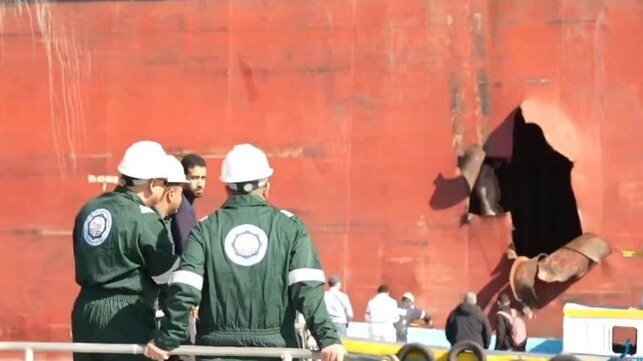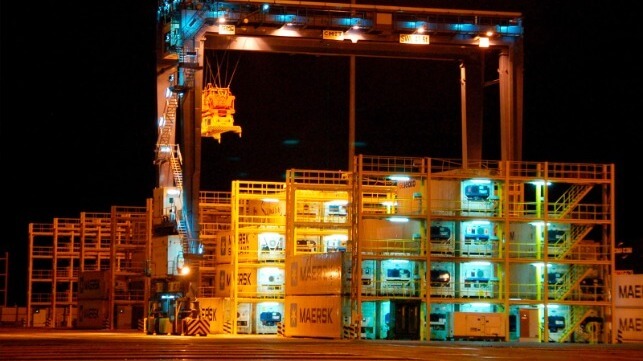Trade Lane Upheavals Divert More Container Cargo to U.S. West Coast

With the Panama Canal restricted by drought and the missile-prone Red Sea abandoned by ocean carriers, U.S. West Coast container ports are getting a back-to-the-future moment - back to the days when they had an ample share of the box shipments from Asia to the East Coast.
The Pamana Canal is currently allocating 24 slots per day for east-west transits, down by a third from the normal 36 slots. This has driven up the price and the waiting time for canal-bound shipping, and has discouraged shipowners from using the waterway.
In the meantime, Yemen's Houthi rebels continue to attack merchant ships in the Red Sea with missiles, armed UAVs and suicide drone boats. The risk is high enough that virtually all container carriers have quit the waterway. (Even CMA CGM, which had been a final holdout among the top-10 operators, is said to have called off using the Red Sea/Suez route after a recent near-miss.)
Asia-U.S. East Coast services that skip the Red Sea must go around the Cape of Good Hope instead, adding thousands of nautical miles to the voyage. For container ships, this equates to an additional 10-14 days of sailing time, plus an extra bunkering stop for smaller vessels.
Luckily for U.S. East Coast retailers and consumers, there is another way to get goods to market: the vast, unencumbered Pacific Ocean. Given the disruption for all-water routes to the Atlantic and Gulf coasts, ″[retailers] have decided to bring cargo into the West Coast ports and then use intermodal rail to get the cargo back to the East Coast,” National Retail Federation VP Jonathan Gold said in congressional testimony last week.
The rising demand for this trade lane is large enough that the Department of Transportation is keeping an eye on possible congestion. Little has been reported yet, but Gold says that his members need to anticipate a surge of traffic in four to six weeks.
Congestion and tight capacity are worth their weight in gold for ocean carriers, and freight prices have been rising rapidly. According to Gold, retailers have reported freight price quote hikes of up to 75 percent in recent weeks. Carriers suggest that the price adjustments are linked to higher operating costs (extra sailing days, extra fuel, bringing more ships into rotation) - but investors have been signaling otherwise. The markets have been bidding up the share price of the top boxship operators by double digits, demonstrating an expectation that the extra revenue will outpace the extra cost.
Vietnam's Ports Benefit From Geopolitics and Trade Wars

[By Selwyn Parker]
Vietnam’s main ports have shot up the world rankings in terms of volumes of container-based traffic as manufacturers increasingly pull out of China in the wake of the tariff-based trade war with America.
As the latest data on Vietnam’s growing “connectivity” – essentially the smooth and cost-effective movement of cargo – with the shipping sector shows, it jumped five places to ninth on the basis of a nearly 14% increase in volumes in the fourth quarter of 2023.
An increase in volumes of this amount is pretty much off the scale. According to supply-chain analyst Sea-Intelligence, Vietnam’s ports grew connectivity by comfortably the highest percentage of all the top 20 nations in the global index, supporting predictions of a few years ago.
Within the Asia-Pacific region, Vietnam was out on its own. For instance, Japan’s connectivity slipped by 7% on the global index, Singapore gained 3%, Malaysia nearly 4%, South Korea a little more than 5% and Hong Kong 11%.
Vietnam’s popularity as a container destination has not come out of the blue. “Vietnam’s connectivity has been on a consistent upward trajectory,” notes Sea-Intelligence’s latest report, citing a substantial jump during the pandemic that has since been maintained.
There are also geopolitical causes for the sustained burst of activity in Vietnam’s main ports. For instance, the extraordinary surge in containerized trade into North America, up by no less than 44% between January and November 2023, is a reflection on the unforeseen consequences of the trade war launched between the United States and China under the Trump administration. Just one notable example is electronics as manufacturers hurriedly relocate production from China to Vietnam.
As the International Monetary Fund’s first deputy managing director, economist Gita Gopinath, told the International Economic Association in late 2023, Vietnam has become the beneficiary of US-imposed tariffs between 2018 and 2019 as Chinese manufacturers and exporters moved quickly to circumvent them. “US imports of Chinese goods subject to the tariffs have been primarily replaced by exports from Vietnam and Mexico of firms that are intricately linked to China’s supply chains,” Gopinath explained.
And, citing nearly new 3,000 trade restrictions imposed globally during 2022, up by nearly three times compared with 2019, Gopinath lamented how trade and foreign direct investment “is now increasingly driven by geopolitical preference rather than by business fundamentals” in a fracturing environment. This is very much the case in Vietnam which is turning into a “connector country”, in economists’ parlance. Not only is the nation of 97 million posting big gains in its share of exports from China, it is also achieving even bigger gains in exports to America.
With ports leading the way, the country’s one-party government plans to carry on where it left off in 2023. Currently, Vietnam ranks only 80th in the world in terms of quality of port infrastructure but, with much of its 3,444-kilometer coastline lying on the South China Sea, it occupies an advantageous natural position from a shipping perspective.
The trade ministry has set a target of boosting exports by 6% through 2024, which most economists consider achievable. After all, Vietnam’s trade deal with the European Union agreed in mid-2019, jumped to a value of more than $50 billion in 2021, its first full year of operation.
The government also aims to double its ports’ capacity to 400 million tonnes by 2030 in a much-needed investment in modernization and expansion. Although most of Vietnam’s 320 ports handle only coastal vessels, some “serve as nodes for the trans-shipment of goods while the larger ports are being upgraded continuously for foreign trade,” explains analyst and publisher Marine Insight.
While 400 million tonnes is seen as ambitious, the government has made a start. For instance, current works at the port of Hai Phong, built by the French 150 years ago in the north of the country, are designed to accommodate bigger vessels up to 100,000 deadweight tonnes.
In contrast with its ports, the government’s shipbuilding aspirations have stumbled. The industry was forecast to post a compound annual growth rate of 6% between now and 2032, but the state-run Shipbuilding Industry Corporation, supposedly the flagship operation, has just collapsed into bankruptcy with enormous debts and the government is trying to rescue it.
More broadly, Vietnam’s current trade boom puts it in the frame as the next Asian tiger. Nearly 20 years ago Goldman Sachs predicted Vietnam would be ranked 21st among global economies by 2025. Today the IMF puts it at 37th with a gross domestic product of $433 billion, nearly the same as Malaysia but lagging a long way behind Poland, the current occupant of 21st position, with a GDP of $842 billion.
However, Vietnam’s prospects appear set to improve in a world of fracturing supply chains.
Selwyn Parker is an author and journalist specialising in Asia-Pacific, European and Latin American issues.
This article appears courtesy of The Lowy Interpreter and may be found in its original form here.
The opinions expressed herein are the author's and not necessarily those of The Maritime Executive.
No comments:
Post a Comment